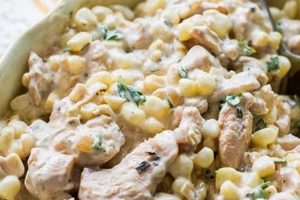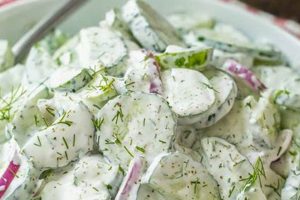A lighter version of the classic dish, this type of preparation focuses on reducing fat and caloric content while retaining the flavor and satisfaction of traditional chicken salad. This is often achieved through ingredient substitutions like using Greek yogurt or light mayonnaise instead of full-fat versions, incorporating more vegetables for added volume and nutrients, and selecting leaner cuts of chicken. An example might include poached chicken breast, celery, grapes, and a dressing of nonfat Greek yogurt seasoned with herbs and spices.
Health-conscious individuals benefit from such recipes as they offer a protein-rich, satisfying meal option without contributing excessive calories or unhealthy fats. This approach aligns with dietary guidelines that promote balanced eating for weight management and overall well-being. Historically, chicken salad became popular as a luncheon dish in the late 19th and early 20th centuries. As dietary awareness increased, variations emerged to address health concerns, leading to the development of these lighter alternatives.
The following sections will explore specific ingredient recommendations, preparation techniques, and variations for creating flavorful, nutritious, and calorie-conscious chicken salads. Nutritional information and tips for meal planning will also be provided.
Tips for Creating Delicious and Healthier Chicken Salad
Achieving a flavorful yet calorie-conscious chicken salad involves careful ingredient selection and mindful preparation. These tips offer guidance for maximizing flavor and nutrition while minimizing unnecessary calories and fat.
Tip 1: Prioritize Lean Protein: Opt for skinless, boneless chicken breasts. Poaching or grilling provides the most healthful cooking methods, avoiding added fats from frying or sauting.
Tip 2: Embrace Greek Yogurt: Substituting Greek yogurt for mayonnaise significantly reduces fat and calories while adding a tangy flavor and creamy texture. Plain, nonfat varieties offer the greatest health benefits.
Tip 3: Boost Flavor with Fresh Herbs: Incorporating fresh herbs like dill, parsley, chives, or tarragon adds complexity and depth of flavor without relying on excess salt or unhealthy fats.
Tip 4: Add Crunchy Texture with Vegetables: Celery, onions, bell peppers, and water chestnuts provide satisfying crunch and valuable nutrients. Consider finely diced carrots or shredded cabbage for additional fiber and vitamins.
Tip 5: Enhance Sweetness Naturally: Grapes, chopped apples, or dried cranberries contribute natural sweetness and textural interest. These additions can satisfy sugar cravings without resorting to refined sugars.
Tip 6: Control Sodium Intake: Use fresh herbs, spices, and lemon juice to enhance flavor, minimizing the need for added salt. Opt for low-sodium or no-salt-added ingredients whenever possible.
Tip 7: Portion Control is Key: Even healthy variations can contribute to weight gain if consumed in large quantities. Be mindful of serving sizes to maintain caloric control.
Tip 8: Explore Flavor Variations: Experiment with different combinations of herbs, spices, fruits, and vegetables to discover new and exciting flavor profiles. Curry powder, smoked paprika, or a touch of Dijon mustard can add unique dimensions.
By following these guidelines, individuals can create satisfying and nutritious chicken salads that support their health goals without sacrificing flavor or enjoyment.
These practical strategies provide a foundation for crafting personalized recipes. The following section offers concluding remarks and encourages further exploration of healthy cooking.
1. Lean Protein Source
Lean protein sources are fundamental to a successful low-calorie chicken salad recipe. Protein promotes satiety and helps maintain muscle mass, making it a crucial component for those seeking a healthy and satisfying meal option. The choice of protein significantly impacts the overall nutritional profile of the dish.
- Chicken Breast:
Chicken breast is a classic choice, offering a readily available and versatile lean protein. Removing the skin and visible fat minimizes calorie and saturated fat content. Poaching, grilling, or baking are preferred cooking methods over frying, further reducing added fats. The neutral flavor profile allows it to readily absorb the flavors of other ingredients.
- Turkey Breast:
Turkey breast offers a similar nutritional profile to chicken breast, providing a lean protein alternative. It possesses a slightly more pronounced flavor which can complement certain recipe variations. Like chicken, it should be prepared using low-fat cooking methods.
- Canned Tuna (in Water):
Canned tuna packed in water is a convenient and budget-friendly lean protein option. Draining the water removes excess sodium. Tuna provides a distinct flavor profile that pairs well with certain vegetables and seasonings. Opting for light tuna can further reduce mercury content.
- Plant-Based Alternatives:
For vegetarian or vegan diets, incorporating plant-based protein sources like chickpeas or lentils offers a high-protein, fiber-rich alternative. These options introduce different textures and flavors, allowing for creative recipe variations. Careful consideration of complementary seasonings is important when using these alternatives.
Selecting an appropriate lean protein forms the foundation of a healthy and flavorful low-calorie chicken salad. The choice influences not only the nutritional content but also the taste and texture of the final dish. Consideration of individual dietary needs and preferences guides the selection process. A well-chosen protein source, combined with other nutritious ingredients, contributes significantly to a satisfying and healthful meal.
2. Reduced-fat Mayonnaise
Reduced-fat mayonnaise plays a crucial role in achieving the low-calorie objective of such recipes. Traditional mayonnaise, with its high fat and calorie content, significantly contributes to the overall richness and caloric density of chicken salad. Substituting reduced-fat mayonnaise directly impacts the nutritional profile, lowering both total fat and calorie counts per serving. This substitution allows individuals to enjoy the creamy texture and familiar flavor of mayonnaise while adhering to dietary goals. For example, replacing one cup of regular mayonnaise (approximately 1440 calories and 160 grams of fat) with one cup of reduced-fat mayonnaise (approximately 480 calories and 48 grams of fat) drastically reduces the caloric and fat contribution to the overall dish.
This ingredient swap impacts not only nutritional values but also the final product’s sensory characteristics. Reduced-fat mayonnaise often possesses a thinner consistency and slightly tangier flavor compared to its full-fat counterpart. This difference can be advantageous, allowing other ingredients’ flavors to shine through. Furthermore, the lighter texture can contribute to a more refreshing overall experience, particularly in warmer weather. However, some individuals might perceive the reduced-fat version as less rich or creamy. This potential drawback can be addressed by incorporating ingredients that enhance creaminess, such as Greek yogurt or mashed avocado, while maintaining the low-calorie focus.
Understanding the impact of reduced-fat mayonnaise on both nutritional content and sensory experience empowers informed decision-making when preparing healthier chicken salads. Careful consideration of individual taste preferences and dietary goals ensures a satisfying and nutritious outcome. Employing strategies to compensate for potential textural differences maximizes the likelihood of achieving a palatable and health-conscious dish.
3. Fresh, Flavorful Vegetables
Fresh, flavorful vegetables are integral to a successful low-calorie chicken salad recipe. They contribute several key benefits beyond simply adding volume. Their inclusion significantly impacts the nutritional value, sensory experience, and overall satisfaction derived from the dish. Vegetables offer essential vitamins, minerals, and dietary fiber, often lacking in richer, traditional versions. This nutritional boost aligns with health-conscious eating patterns, providing valuable micronutrients and promoting digestive health. For example, incorporating chopped celery adds vitamin K and folate, while diced bell peppers contribute vitamins A and C. These additions transform a simple protein-based dish into a nutrient-dense meal.
Beyond nutritional enhancement, fresh vegetables contribute significantly to the sensory appeal of the salad. Their crisp textures and vibrant colors contrast with the softer texture of the chicken and dressing, creating a more engaging and enjoyable eating experience. The variety of flavors offered by different vegetablesthe subtle bitterness of celery, the sweetness of bell peppers, the sharpness of red onionadds complexity and depth, reducing the need for excess salt or fat to achieve palatability. Consider, for instance, the interplay of textures and flavors achieved by combining crunchy celery, sweet grapes, and peppery water chestnuts. This combination creates a multi-dimensional sensory experience that enhances enjoyment and promotes satiety.
The strategic use of fresh vegetables allows for significant calorie reduction without sacrificing flavor or satisfaction. Their high water and fiber content contributes to a feeling of fullness, promoting portion control and aiding in weight management efforts. By emphasizing flavorful, nutrient-rich vegetables, individuals can create a satisfying and health-conscious meal that supports overall well-being. This approach allows for the creation of a dish that is both delicious and conducive to a healthy lifestyle. The thoughtful selection and incorporation of fresh vegetables are therefore crucial for optimizing the nutritional and sensory qualities of a low-calorie chicken salad recipe.
4. Portion Control
Portion control is a critical element in managing calorie intake and achieving weight management goals, even with inherently healthier options like low-calorie chicken salad. While the recipe itself contributes to reduced calorie density, consuming excessive quantities negates these benefits. Understanding portion sizes and employing effective strategies for managing them is crucial for maximizing the health benefits of such recipes.
- Visual Cues:
Visual cues offer practical methods for estimating appropriate portion sizes without relying on measuring tools. For instance, a serving of chicken salad might be visualized as the size of a deck of cards or a woman’s fist. These readily available comparisons provide convenient benchmarks, particularly in settings where measuring cups or scales are unavailable. Such estimations assist in preventing overconsumption, especially when dining out or at social gatherings.
- Pre-portioning:
Pre-portioning involves dividing food into individual serving sizes before consumption. This practice proves particularly effective with dishes like chicken salad, which are often served from a larger container. By pre-portioning into smaller containers or using meal prepping techniques, individuals establish clear boundaries for each meal. This prevents mindless overconsumption and reinforces mindful eating habits, promoting long-term dietary management.
- Mindful Eating Practices:
Mindful eating practices encourage a heightened awareness of hunger and fullness cues. Paying attention to these internal signals helps prevent eating beyond satiety. This practice fosters a deeper connection with the body’s natural regulatory mechanisms, promoting healthier eating habits over time. In the context of low-calorie chicken salad, mindful eating allows individuals to fully appreciate the flavors and textures while recognizing when they are satisfied, even with a smaller portion.
- Plate Composition:
Plate composition plays a significant role in portion control. Balancing the chicken salad with other nutrient-rich, lower-calorie foods like leafy greens or a side of mixed vegetables creates a visually appealing and satisfying meal without relying on an oversized portion of the salad itself. This approach helps manage overall calorie intake while ensuring a balanced and nutritious meal. For example, serving a moderate portion of chicken salad alongside a generous serving of mixed greens enhances satiety and provides additional nutrients.
Integrating these portion control strategies maximizes the health benefits of consuming low-calorie chicken salad. By maintaining awareness of appropriate serving sizes and practicing mindful eating habits, individuals can enjoy this nutritious and flavorful dish while effectively managing calorie intake and supporting their overall health and weight management objectives.
5. Creative Seasonings
Creative seasonings are essential for maximizing flavor complexity in low-calorie chicken salads. Since reducing fat and calories can sometimes lead to perceived blandness, innovative seasoning combinations become crucial for creating a palatable and enjoyable dish. Strategic use of herbs, spices, and other flavor enhancers elevates the sensory experience while adhering to dietary guidelines.
- Fresh Herbs:
Fresh herbs offer vibrant flavors and aromatic complexity. Dill, parsley, chives, and tarragon contribute distinct notes that enhance the overall taste profile without adding calories or sodium. For example, dill adds a bright, slightly tangy flavor, while parsley provides a fresh, herbaceous note. These additions create a more dynamic and interesting flavor profile, compensating for the reduced richness from lower-fat ingredients.
- Spices:
Spices introduce warmth and depth. Curry powder, smoked paprika, and cumin offer distinctive flavor profiles suitable for creating globally-inspired variations. A small amount of smoked paprika can add a smoky depth, while curry powder introduces a complex blend of aromatic spices. Such additions cater to diverse palates and prevent flavor monotony, especially when preparing multiple batches of low-calorie chicken salad.
- Citrus Zest and Juice:
Citrus zest and juice provide a refreshing brightness and acidity that cuts through the richness of the chicken and other ingredients. Lemon, lime, and orange zest contribute aromatic oils that enhance the overall sensory experience. A squeeze of lemon juice adds a tangy note that balances the flavors and brightens the palate. These additions create a lighter, more refreshing flavor profile, particularly appealing in warmer weather.
- Flavorful Vinegars:
Flavorful vinegars, such as apple cider vinegar or balsamic vinegar, introduce complexity and depth. Apple cider vinegar offers a slightly sweet and tangy note, while balsamic vinegar provides a richer, more complex flavor profile. These additions enhance the overall taste and can contribute to a more satisfying sensory experience. Used sparingly, they add depth without overwhelming the other flavors.
By strategically combining fresh herbs, spices, citrus elements, and flavorful vinegars, individuals can create low-calorie chicken salads that are both nutritionally sound and palatably satisfying. This approach allows for diverse flavor profiles and ensures that reducing calories does not equate to sacrificing taste. Creative seasoning becomes a defining factor in recipe success, elevating the dish from simple to exceptional.
6. Healthy Preparation Methods
Healthy preparation methods are crucial for maintaining the low-calorie nature of chicken salad. Cooking techniques directly impact calorie and fat content. Poaching or grilling chicken breast, for example, minimizes added fats compared to frying. These methods retain moisture and flavor without relying on high-calorie oils or butter. Steaming vegetables preserves nutrients and avoids the added fat of sauting. Chopping vegetables uniformly ensures even cooking and optimal texture in the final salad.
The impact of preparation methods extends beyond calorie control. Nutrient retention is significantly influenced by cooking techniques. Gentle methods like steaming or blanching preserve water-soluble vitamins often lost during boiling. Minimizing cooking time also helps retain nutrients and prevents overcooking, which can lead to a dry, less palatable salad. Choosing healthy preparation methods contributes to a more nutritious and flavorful final product. For example, grilling chicken imparts a smoky flavor that enhances the overall taste profile without relying on high-calorie marinades or sauces.
Employing healthy preparation methods ensures the nutritional integrity and flavor profile of a low-calorie chicken salad. These techniques contribute significantly to achieving dietary goals without compromising palatability. Careful consideration of cooking methods ensures a healthy and enjoyable meal that aligns with calorie-conscious objectives.
Frequently Asked Questions
This section addresses common inquiries regarding the preparation and consumption of low-calorie chicken salad.
Question 1: How can one ensure chicken salad remains low in calories without sacrificing flavor?
Flavor can be maximized through the incorporation of fresh herbs, spices, and zesty citrus elements. These ingredients add depth and complexity without contributing significant calories.
Question 2: What are suitable alternatives to mayonnaise for reducing overall fat content?
Plain, nonfat Greek yogurt or mashed avocado offer creamy textures and healthy fats while significantly reducing calorie and saturated fat content compared to traditional mayonnaise.
Question 3: What vegetables contribute most effectively to both flavor and nutritional value?
Celery, bell peppers, red onion, and water chestnuts offer varied textures, flavors, and essential vitamins and minerals.
Question 4: How can portion sizes be effectively managed to support weight management goals?
Pre-portioning salad into individual containers and employing visual cues for estimating appropriate serving sizes promote mindful consumption and prevent overeating.
Question 5: What are optimal storage methods for maintaining freshness and food safety?
Refrigeration in airtight containers is crucial. Chicken salad should be consumed within three to five days to minimize spoilage risk.
Question 6: Can this type of salad be incorporated into a variety of meal plans?
Its versatility allows for inclusion in sandwiches, wraps, lettuce cups, or as a standalone dish alongside a variety of complementary sides.
Careful consideration of ingredient selection, portion control, and preparation methods ensures a nutritious and flavorful experience aligned with health-conscious objectives.
The following section offers a collection of varied recipes for practical application of these principles.
Chicken Salad
Exploration of low-calorie chicken salad recipes reveals the potential for enjoying a flavorful, satisfying meal while adhering to health-conscious dietary guidelines. Careful selection of lean protein sources, utilization of reduced-fat alternatives to traditional mayonnaise, and incorporation of fresh, nutrient-rich vegetables contribute significantly to minimizing caloric intake without sacrificing taste or texture. Emphasis on portion control and creative seasoning techniques further enhances the experience, allowing for a balanced and enjoyable approach to healthy eating.
The versatility of chicken salad, adaptable to various flavor profiles and dietary preferences, positions it as a valuable component within diverse meal plans. Continued exploration of innovative ingredient combinations and preparation methods offers opportunities to further refine culinary approaches that prioritize both health and enjoyment. This focus on mindful ingredient selection and preparation empowers individuals to make informed dietary choices that support overall well-being.






